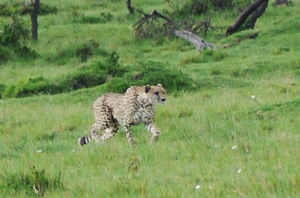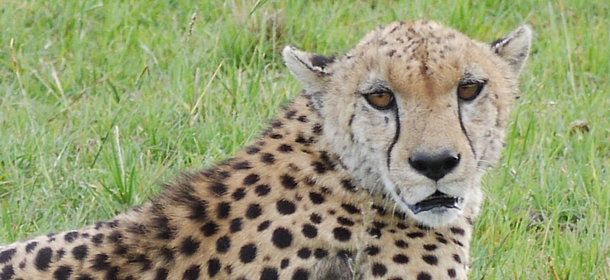 The Masai Mara is one of the best places in Africa to see cheetahs. These sleek predators are built for speed and the open, flat grasslands of the Mara are perfect for them. Its favourite prey are gazelle – Thomson gazelle or Impala are a realistic meal for a cheetah, providing plenty of meat for it and its cubs should there be any to feed.
The Masai Mara is one of the best places in Africa to see cheetahs. These sleek predators are built for speed and the open, flat grasslands of the Mara are perfect for them. Its favourite prey are gazelle – Thomson gazelle or Impala are a realistic meal for a cheetah, providing plenty of meat for it and its cubs should there be any to feed.
There’s not much point hunting anything much bigger. There’s more chance of injury if the prey is heavier and stronger, not an attractive option for the thin-limbed cheetah who relies on speed. Should it kill a larger animal it probably wouldn’t be able to enjoy it all. It would be chased off the kill by lions or hyenas and it doesn’t have the body strength or requisite skills to drag it up into a tree as a leopard would do.
Unlike leopards and lions, cheetahs hunt during the day, needing the light to spot, assess and chase their prey. You would think this would make spotting a hunt easier, but it’s still an unusual thing to witness – most cheetahs spend their time lying asleep in the grass or watchfully sitting on an old termite mound.
When hunting, the cheetah will first spend time finding a suitable target, one that is oblivious to its presence. This is easier said than done. When you are a big cat, all animals are wary of you, and they will be on a constant alert. Topis, a large antelope, are particularly attentive, often positioning one of their group onto a termite mound to get a better view. If they see cheetah they will often follow them, chasing them off, and making noise to warn other animals and make the cheetahs move on to a new area.
 Warthogs too are quick to sense danger, their tails going bolt upright and running away. This movement is enough to warn the Impala and Thomson that danger is at hand and to make them wary.
Warthogs too are quick to sense danger, their tails going bolt upright and running away. This movement is enough to warn the Impala and Thomson that danger is at hand and to make them wary.
When a cheetah does spot a tempting target it makes sure it’s downwind so that its smell won’t warn it. They will fix their gaze onto it and painstakingly stalk towards it. The targets often have their rumps towards the cat, one reason it will have been picked out in the first place. They are often grazing so they are preoccupied.
 Should they look up the cheetah will freeze, keeping completely still until the gazelle either looks away or continues eating. Should the cheetah sense the target is suspicious in any way it will drop to the ground to make itself invisible until the animal settles again.
Should they look up the cheetah will freeze, keeping completely still until the gazelle either looks away or continues eating. Should the cheetah sense the target is suspicious in any way it will drop to the ground to make itself invisible until the animal settles again.
This process continues until the cheetah gets close enough to unleash its speed. This will depend on the species of prey, its age and its agility. A baby gazelle is easy to catch and can be chased from a longer distance, as can animals that are obviously injured or old. For an adult Thomson gazelle, the cheetah will try to get within 100-120 metres.
It then starts a stealthy run to close the distance further and, if not spotted, will unleash its sprint to make the kill. The whole time they are completely fixed on the prey they chose at the start of the hunt, sometimes running past other targets to get to the one they originally judged as being the best option. If they are successful they will knock the animal to the ground before holding it by the neck and suffocating it by biting and holding its neck. If they are unsuccessful, and they frequently are, they collapse to the ground to recover from the exertion, knowing that now the animals know of their presence they will have to move on and start the whole procedure again.
